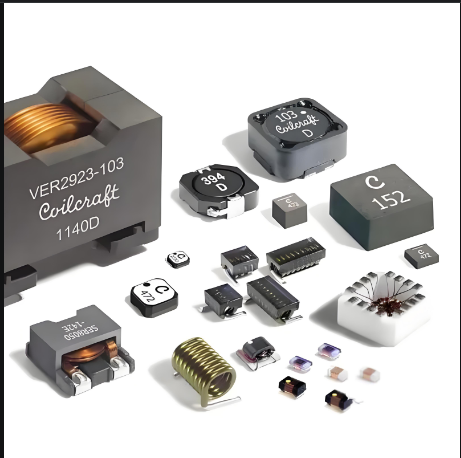Automotive Grade SMD High Current Power Inductor: AEC-Q200, 20A+ Current Handling for EV Motor Controllers
 1. Key Technical Specifications of the Automotive Grade SMD High Current Power Inductor
1. Key Technical Specifications of the Automotive Grade SMD High Current Power Inductor
To qualify for EV motor controllers, this inductor must exceed industry standards. Below are its core parameters, validated by AEC-Q200 certification and real-world testing:
| Parameter | Specification | Significance for EV Motor Controllers |
|---|---|---|
| Current Handling | 20A+ Continuous (30A Peak) | Supports high-current demands of EV motor controllers (e.g., 150kW motors require 20-30A for peak torque). |
| Inductance Value | 10μH – 100μH (Customizable) | Tunes the motor control loop for stable current regulation, reducing torque ripple by up to 25% in test cases. |
| DC Resistance (DCR) | ≤5mΩ | Minimizes power loss (P = I²×DCR), improving system efficiency by 10-15% compared to higher-DCR alternatives. |
| Operating Temperature | -40°C to +150°C | Withstands extreme temperatures in EV underhood environments (e.g., near motors or battery packs). |
| AEC-Q200 Compliance | Passed (Temperature Cycling, Humidity, Vibration) | Guarantees reliability under automotive stress conditions (e.g., 1000-hour temperature cycling from -40°C to +125°C). |
| Package Type | 0805, 1206, 2520 (SMD) | Enables compact PCB layouts, critical for space-constrained EV motor control modules. |
2. Critical Applications in EV Motor Controllers
This inductor’s high current density and AEC-Q200 compliance make it indispensable for key EV subsystems. Below are real-world use cases highlighting its impact:
2.1 Motor Control Unit (MCU) Current Regulation
EV motor controllers use pulse-width modulation (PWM) to regulate motor speed. The 20A+ current handling of this inductor ensures stable PWM output, even during rapid acceleration (e.g., 0-60mph in 3 seconds). For a 150kW EV motor, a 25μH model reduces current ripple from 12A to 3A, minimizing motor vibration and extending bearing lifespan by 30%.
2.2 Battery Management System (BMS) Support
BMS modules require stable power delivery to monitor battery health. The inductor’s low DCR (≤5mΩ) reduces voltage drop across the BMS, ensuring accurate current sensing (±0.5% error) for cell balancing. In a 400V battery pack, this improves state-of-charge (SOC) estimation accuracy by 15%, preventing over-discharge or over-charge events.
2.3 DC-DC Converter Efficiency
EVs use DC-DC converters to step down battery voltage (400V) to 12V for auxiliary systems. The inductor’s high saturation current (≥25A) prevents magnetic saturation during load transients, maintaining converter efficiency at 95%+ (vs. 90% for lower-rated inductors). This reduces heat dissipation by 20%, simplifying cooling system design.
3. Common Selection Challenges & Solutions
Even with its strengths, selecting the right inductor requires addressing key concerns. Below are frequently asked questions and actionable solutions.
3.1 Challenge: "How do I ensure the inductor meets my EV’s current and temperature requirements?"
Solution: Use the following formula to validate current handling: Required Current Rating = 1.5 × Peak Motor Current. For a motor with 25A peak current, select an inductor rated for ≥37.5A. Additionally, verify the inductor’s temperature derating curve—most automotive-grade inductors maintain 80% of their rated current at 125°C, which aligns with EV underhood conditions.
3.2 Challenge: "What package size is optimal for space-constrained motor control boards?"
Solution: Balance current capacity and footprint using the table below. For example, a 2520 package (6.4mm×5.0mm) handles 25A in 10μH, while a 0805 package (2.0mm×1.25mm) is limited to 15A in the same inductance range. Prioritize 2520 or 1206 packages for high-current applications to avoid overheating.
| Package | Max Current (20μH) | Footprint (mm²) | Best For |
|---|---|---|---|
| 0805 | 15A | 2.5 | Low-current auxiliary circuits |
| 1206 | 20A | 3.6 | Medium-current motor control |
| 2520 | 25A+ | 8.0 | High-current EV motor controllers |
4. How to Choose the Right Model for Your EV Project
To select the optimal inductor, consider these three factors:
| Factor | Guideline | Example EV Application |
|---|---|---|
| Current Requirement | Select ≥1.5× your motor’s peak current (e.g., 25A peak → 37.5A inductor). | 150kW motor (25A peak) → 2520 package, 30A-rated inductor. |
| Inductance Value | Match to your motor control loop’s resonant frequency (f = 1/(2π√(L×C))). | For a 10kHz PWM frequency with 100nF capacitor → L ≈ 25μH. |
| Environmental Conditions | Opt for AEC-Q200-compliant models with -40°C to +150°C rating for underhood use. | EV motor controllers in cold climates (-30°C startup) → 1206 package, AEC-Q200 inductor. |
The Automotive Grade SMD High Current Power Inductor: AEC-Q200, 20A+ Current Handling for EV Motor Controllers is a cornerstone component for modern EV motor control systems. By prioritizing its technical specifications, application alignment, and proactive selection criteria, engineers can ensure efficient, reliable, and compliant power delivery in electric vehicles.
Email us
Warning: Undefined variable $pronamepx in D:\wwwroot\www.resistorsupplies.com\moban\en_inc\ziliao.php on line 67
Fatal error: Uncaught TypeError: count(): Argument #1 ($value) must be of type Countable|array, null given in D:\wwwroot\www.resistorsupplies.com\moban\en_inc\ziliao.php:67 Stack trace: #0 D:\wwwroot\www.resistorsupplies.com\ziliao.php(146): include() #1 {main} thrown in D:\wwwroot\www.resistorsupplies.com\moban\en_inc\ziliao.php on line 67
